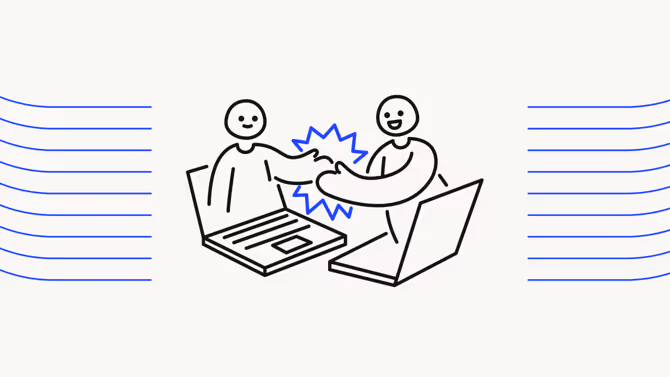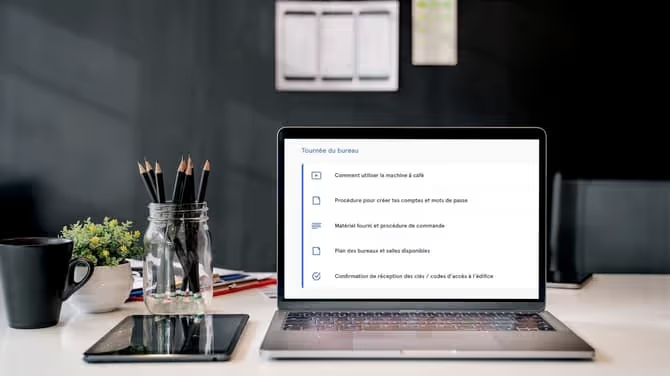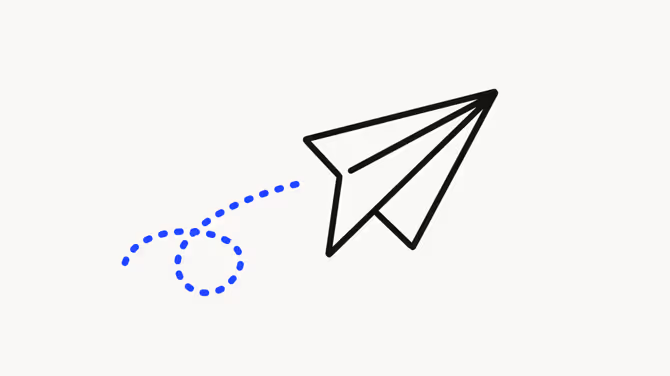5 ways to wow new hires with welcome videos

Streamline, organize, and automate your onboarding process like magic.

Think back to your very first day at your job. You probably felt hyped up, filled with potential, and ready to make an impact. Maybe you also had some butterflies in your stomach…
When new hires join your team, you want to tap into those positive emotions right away and quell any anxieties so they feel empowered to hit the ground running. Welcome videos can do just that. They’re a great way to share important information, show off your company culture, and create a sense of inclusion for new employees. And they help build connections in a way that’s tough to do through an email or employee handbook.
Incorporating video into your employee onboarding journey has a dynamic potential to shape the entire experience. Ready to dive in?
The power of video in onboarding
Welcome videos provide a personal touch for new employees joining your organization. They help to convey your company’s culture, mission, and values more effectively, fostering alignment from the outset. Not only that, but welcome videos have the power to create a deeper sense of belonging, helping new employees feel that they’re a part of something—even if they’re onboarding remotely.
Videos help communicate intangibles and create a more up-to-date and engaging onboarding experience. And for those reasons, more and more HR professionals are making them a must-have in their onboarding workflows.
An experience that lands: Why HR professionals should prioritize welcome videos
How people consume information has dramatically shifted. People don’t spend time reading long-form text like they used to, and many prefer to get their information through short-form, snappy video clips. This trend is not just a fad—it's a fundamental change in communication style, one that employers must notice as Gen Z continues to make up more of the workforce. You want to create an experience that’s engaging, familiar, and true to people’s habits. The facts speak volumes:
- On average, individuals spend an impressive 17 hours a week watching online videos (Statista).
- A remarkable 91.6% of internet users aged 16-64 engage with online video content every week (Hootsuite).
These numbers aren't just figures. They represent a clear message: Video is the new language of engagement. Not only is video a preferred form of content consumption for many, but it will likely lead to better information retention.
Viewers retain 95% of a message when they watch it in video compared to 10% when reading in text. - Forbes
Plus, they also add a dynamic layer to the onboarding experience, balancing out live calls, document reviews, and task completions to make the first days more engaging for the new hire. And a highly engaging experience from the jump can lead to better retention rates down the line.
5 tips for better welcome videos (with examples)
It’s clear that video content adds to the employee onboarding experience. But how do you create valuable welcome videos that hit the right mark? Without guidance, you risk creating videos that lack a clear message and purpose. Follow these best practices (and examples) to craft exceptional welcome videos to add to your onboarding workflows.
1. Curate your content
Before you hit record, think about what information you want to communicate via video during employee onboarding. Certain things can simply be added to a checklist, and other things warrant a meeting or training session. Here are a few examples of what might be effectively presented in a video format:
- Give an overview of the onboarding process and key resources
- Present company history, mission, and up-to-date strategic pillars
- Share company culture, values, and what’s expected of employees
- Introduce departments and their objectives within the organization
- Walk through employee benefits, perks, resources, and processes
- Share how performance is tracked, evaluated, and rewarded
- Highlight the important parts of a document to make sure they are understood
While any of these could make great video content, it’s also important to create opportunities for new hires to ask questions and get clarification as needed. Feedback forms, one-on-ones with managers, and clear documentation are also essential parts of onboarding, too. These are all ways to address any uncertainties and share further context and information—not to mention an opportunity to forge those human connections that really make the difference.
2. Select the best channel
Once you’ve recorded your videos, it’s also important to think about how you’ll share them. File formats and device compatibility can quickly wreak havoc on your carefully crafted communications. And to make a new employee dig around in Slack or an intranet to find those videos? Yikes. These are just a few examples of how to get the technical side of video creation set up for smooth sailing:
- If your company is currently using a video tool for live videos, see if a recording option exists
- Find a dedicated space to store welcome videos, so they’re easy to find and add to onboarding flows
- Make sure videos are saved and shared in a format and location that’s accessible and compatible across devices
- Create a dedicated space for new hires’ onboarding, too, where they can find everything they need in one place
{emphasize}📹 Need a good tool for onboarding welcome videos?{emphasize}
Workleap Onboarding helps you record welcome videos and share them in the same environment where new employees complete all of their onboarding. It’s like a home base for new hires. Employees can access files, checklists, videos, and more, and track their progress along the way.

3. Make it personal
You want new hires to feel recognized as individuals and valued for the unique contributions they’ll be making to your organization. Personalization goes beyond making sure to use their name in a custom video (but you should do that, too). Creating a sense of inclusion in your videos comes in a variety of forms, and details that might seem minor can speak volumes. For example:
- Set some guidelines for hiring managers to create a unique video welcoming each new team member. Such as specifying that they should use the new hire’s name, emphasizing the importance of their role, and mentioning a few things about them learned in the hiring process.
- Have team leaders get team members to film short clips introducing themselves, and compile them into a welcome video for new employees. At the end of each person’s onboarding, they can film their own clip to add to the latest version for the next person who joins.
- Create welcome videos that include employees from different departments, geographical locations, and job functions. Showcase the diversity within your workforce to demonstrate to new hires it’s a welcoming environment for all.
- Implement some general inclusivity practices in how you produce your welcome videos. For example, have people’s names, job titles, and pronouns written alongside them when they’re speaking. Or, give people the option to record their video parts as audio-only.
Ultimately, it’s all about demonstrating an awareness that every team member is more than just a worker. When you name people, use their pronouns, show what makes them unique, and let them participate in a way they’re most comfortable. It’s a sign of respect—and of recognition. It’s a way of saying ‘I see you’, and this will come through for the new joiners watching, evoking a sense of belonging from the very beginning.
{emphasize}🎬 Use Workleap Onboarding video to send clip requests to teammates
Lights, camera, action! With Workleap Onboarding, you can easily curate an extra memorable first-day experience for your new hires. Invite managers and team members to record personalized welcome videos, creating a warm and inclusive atmosphere from the start.
Here's how it works: Send out clip requests through Workleap Onboarding, and each designated colleague will receive a notification to record their message in our user-friendly video studio.
This small gesture can make a world of difference in creating an instant sense of belonging and connection for new team members.{emphasize}
4. Be clear, keep it concise
Only 66% of viewers will finish a video that’s under 1 minute long—and that number drops as the length of a video increases (VidYard). So you want to make sure you’re keeping it streamlined. This can be done in a number of ways, but here are some examples of how you might clarify your message and pare it down:
- Use text in your video to highlight the most important things you say
- Write a video script (or work with a writer) and edit it mercilessly
- Try asking ChatGPT to eliminate wordiness from your script
- Narrow down 3-5 key takeaways for your video, and include them at the end
- If you can’t get it down to under 2 minutes, reconsider your format
{emphasize}📝 Workleap’s video recording tool comes with a notes section built-in. Stay on-script and avoid side-tangents with your speaking cues right there as you record. Plus, you won’t have those shifty eyes from glancing at a Word doc on another screen throughout.{emphasize}
5. Mix it up when you need to
Remember only some messages will be right for a video. The point is not to set new hires up with a YouTube playlist and some popcorn. There are plenty of things you’ll want to cover in onboarding that are better suited to a live meeting, need to be in writing, or can be assigned as tasks. Here are a few examples:
- Going over a new hire’s job description and responsibilities. Provide these essentials in writing and review them in a live one-on-one meeting between the employee and their manager.
- Meet and greet with their team, key collaborators, and leadership members. These can be spread out over their first weeks and even months, but it’s important to get face time with people they’ll be working closely with.
- Setting up accounts and getting access to various documents and systems. It's easier to provide these types of details as a checklist they can go through one-by-one. If they hit any roadblocks, they can flag it to their manager or IT.
- Setting goals for their first 30 days, 60 days, and 90 days. Goal setting should be collaborative with their manager, and then they should have live check-ins at each milestone.
- Registering for benefits or setting up perks. Not only is their 401K, RRSP contribution amount or which benefits package they select personal, but it also definitely needs to be in writing.
Video welcomes are great, and they can cover a lot of ground. But some stuff is simply better suited to other formats, so don’t try to fit a square into a circle. Human connection is also essential in the onboarding experience, so make plenty of space for it
A little video can go a long way
So, are you ready to elevate your onboarding game with the compelling impact of personalized video welcome messages? In a remote-first workforce, establishing human connection can be tricky but undeniably essential. Integrate videos into your onboarding journey to unveil your team's unique personality while encouraging new hires to express theirs. Thoughtfully crafted welcome videos propel engagement from day one and cultivate a genuine sense of belonging, even within distributed teams.
Experience their impact firsthand by trying Workleap Onboarding. From delivering warm and personalized welcomes to each new hire to tailoring messages, videos, and resources, Workleap makes sure that employees feel valued and seamlessly integrated into the team from the very start.
%20(1).png)

%20(1).avif)


.avif)
.avif)








